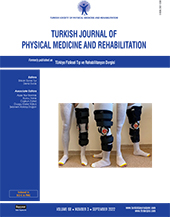Investigation of the effectiveness of neck stabilization exercises in patients with chronic neck pain: A randomized, single-blind clinical, controlled study
2 Department of Physical Medicine and Rehabilitation, Dokuz Eylül University Faculty of Medicine, Izmir, Türkiye
3 Department of Physical Medicine and Rehabilitation, Foca Public Hospital, Izmir, Türkiye
4 Department of Biostatistics and Medical Informatics, Dokuz Eylül University Faculty of Medicine, Izmir, Türkiye DOI : 10.5606/tftrd.2022.8481 Objectives: This study aims to compare the efficacy of neck stabilization exercises versus a conventional exercise program on pain, range of motion, disability, and depression in patients with chronic neck pain.
Patients and methods: This prospective, single-blind, randomized controlled study included 60 patients with chronic neck pain, 58 (21 males, 37 females; mean age: 36.7±8.5 years; range, 18 to 55 years) of whom completed the study. The patients were randomized into two groups. Patients in one group were given neck stabilization exercises, while the patients in the other group were given conventional neck exercises. Neck pain due to activities of daily living (Visual Analog Scale), neck range of motion in sagittal, transverse, and frontal planes, disability (Neck Disability Index), and depression (Beck Depression Inventory) were evaluated at the beginning, at the end of the treatment, and at the first and third months after the end of treatment.
Results: Significant improvement was achieved in both groups in terms of Visual Analog Scale, Neck Disability Index, neck range of motion in the sagittal, transverse, and frontal planes, and Beck Depression Inventory compared to the beginning of treatment (p<0.05). In the stabilization exercise group, statistically significant improvement was found in the range of motion of the neck in the transverse plane (p<0.05).
Conclusion: Stabilization exercise programs, which show their effect by maintaining segmental stabilization, postural control, and balance between the superficial and deep muscles of the neck region, contribute to reduced pain in daily activities and improved function similar to conventional exercise programs.
Keywords : Chronic neck pain, conventional neck exercise, neck stabilization exercise

















